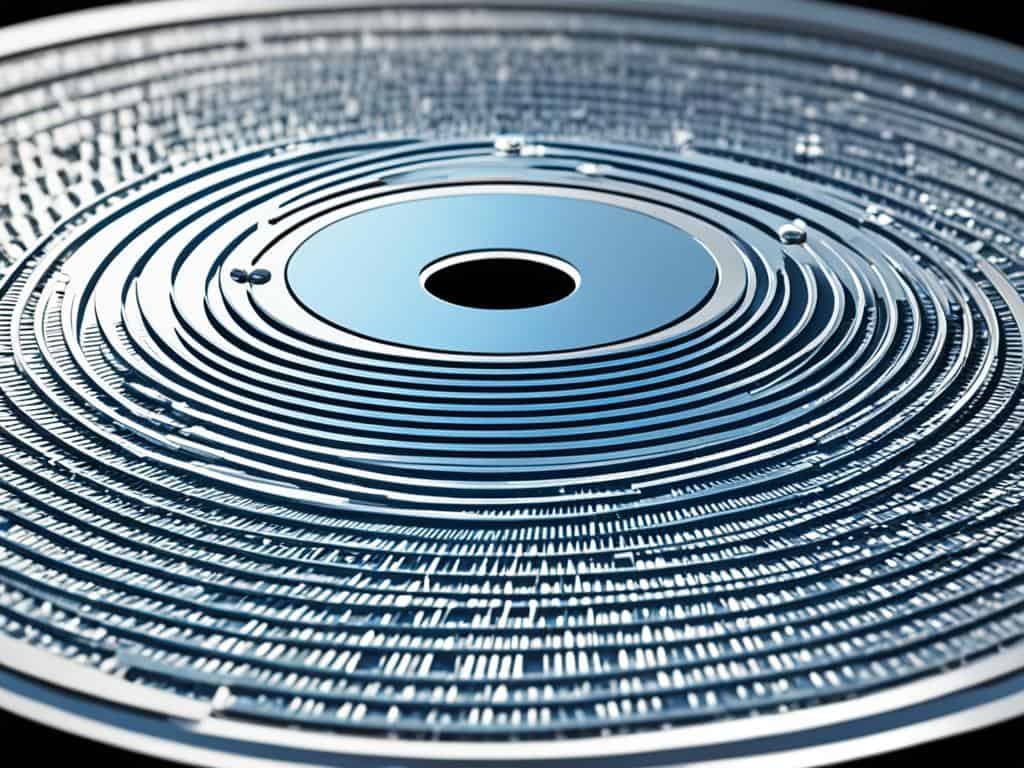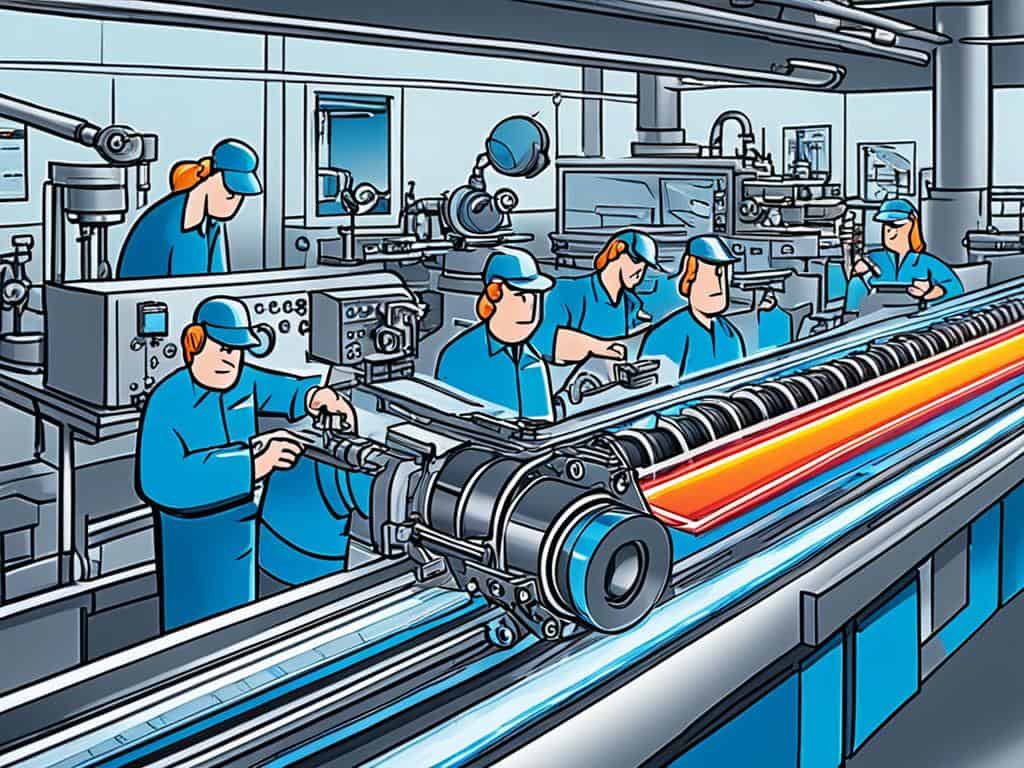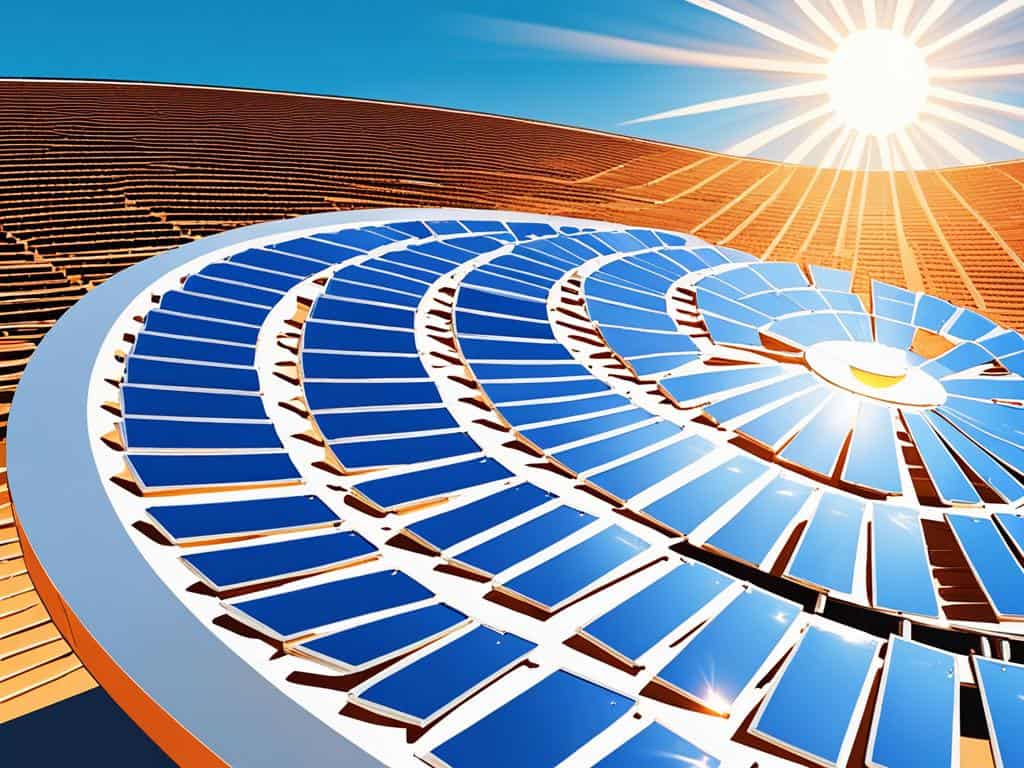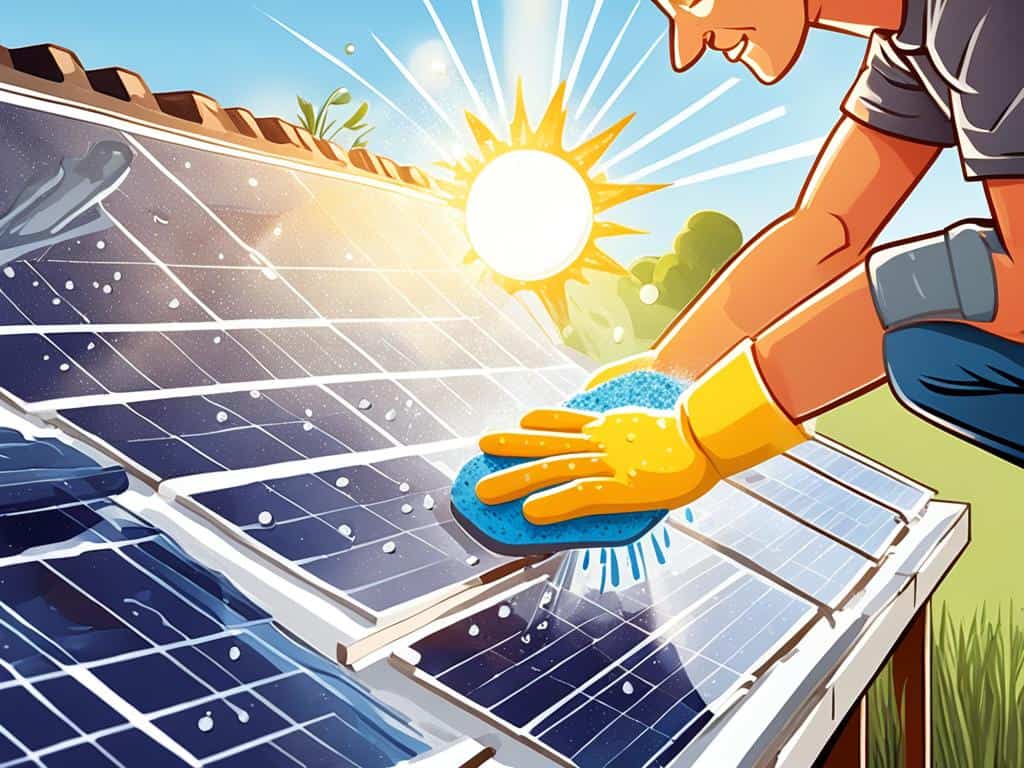Innovative Solutions: Fresnel Lens Collectors Explained
Discover the power of fresnel lens collectors as they revolutionize solar energy harvesting for a sustainable future in renewable energy technology.

In the move to more renewable energy, one key invention stands out. It can concentrate sunlight up to 500 times its normal power—Fresnel lens collectors. These powerful lenses boost the sun’s power on photovoltaic (PV) cells. This change is making solar energy more efficient and eco-friendly.
Made mainly of acrylic, Fresnel lenses are known for letting a lot of light through. This quality is important for visible and ultraviolet light. Their smart design quickly reaches high temperatures. This helps turn more solar power into electricity. Their history spans from old lighthouses to today’s solar tech. The journey of the Fresnel lens collector is a story of constant invention.
Key Takeaways
- Revolutionary 500:1 concentration ratio maximizes sun impact on PV cells.
- Acrylic-made Fresnel lenses boast exceptional transmittance, enhancing solar collection.
- Design and materials optimize Fresnel lens collectors for high conversion efficiency in solar energy systems.
- Fresnel lenses adeptly collimate light, pivotal for both high and mid-temperature solar applications.
- The scaling use across various sectors showcases Fresnel lens collectors as versatile, cost-effective, and lightweight components in sustainable energy solutions.
Understanding the Basics of Fresnel Lens Collector Technology
The creation of Fresnel lens technology has changed how we gather solar energy. These lenses help us achieve higher energy efficiency and sustainability in using renewable energy.
What is a Fresnel Lens?
A Fresnel lens breaks a normal lens into thinner, flat rings called segments. These segments act like a regular lens but are lighter and more functional. They bend light towards a focal point, keeping optical efficiency high.
Optical Components and Their Arrangement
Fresnel lenses use grooved and flat segments to focus light precisely. Each part works together to increase the light’s intensity. This design boosts sunlight harvesting and improves the performance of photovoltaic (PV) cells.
The Path from Thick Lenses to the Innovative Fresnel Lens
Moving from traditional to Fresnel lenses was a big step forward for renewable energy. These thin lenses are efficient without being heavy. They help us gather sunlight better and reach higher temperatures quickly.
Fresnel lenses can focus sunlight intensely, with ratios up to 500:1. This improves how PV cells function. They can gather a lot of light and reach temperatures up to 600°C fast. This heat is important for thermal power systems to work well.
In the United States, solar thermal power plants show how versatile these lenses are. Places like SEGS in the Mojave Desert use this technology to concentrate solar power. There are different setups, including solar power towers and compact Fresnel reflectors. These show the strength and flexibility of the technology in renewable energy.
The fresnel lens collector technology is truly remarkable. It combines optical efficiency with sustainability, leading the way in renewable energy advancements.
Manufacturing the Fresnel Lens: A Blend of Art and Science
The production of Fresnel lenses combines precise engineering with artistic skill. These lenses are key in sustainable energy solutions. They moved from traditional glass grinding to high-tech production. Now, advanced plastic injection molding is key in making these lenses. Acrylic and polycarbonate materials make the lenses effective and enhance solar concentrators’ efficiency.

The stats on Fresnel lenses are impressive. For example, the first-order Fresnel lens in Paris’ Musée national de la Marine is 2.54 meters tall and weighs about 1.5 tonnes. It uses a design that captures light with great precision.
The design ingenuity of the Fresnel lens lies in its ability to offer large aperture and short focal length sans the unwieldy mass and volume of material necessitated by conventional lenses.
In 1823, the Cordouan Lighthouse used the first Fresnel lens to send light over 32 kilometers. By 1825, Augustin-Jean Fresnel added a rotating mechanism to the lens. This improved how it spread light across the horizon.
In sustainable energy, concentrated solar power (CSP) is important. It uses special materials like porous silicon carbide. These materials cut heat loss and need less heat to work. They show the hard work in making energy conversion efficient.
- CSP could provide 11% of global electricity by 2050, from 0.5% now.
- Volumetric solar receivers get very hot and are crucial in CSP systems.
The SOLAIR project showed how effective Fresnel lenses can be in CSP. It reached thermal efficiencies of 74% to 75%. The NEXTOWER project aims to boost this efficiency further. This project tackles thermal cycling and shock in solar receivers.
Thanks to improved production and materials, Fresnel lenses are vital in solar energy. They embody both art and science. The Fresnel lens is essential for sustainable energy solutions. It helps us move towards a future where energy is plentiful and eco-friendly.
The Working Principles of the Fresnel Lens Collector
The introduction of fresnel lens collectors has advanced the concentrated solar power field significantly. They use the power of renewable energy for efficient applications. These optical components push green energy forward and enhance energy efficiency with their design.
At the heart of their design is the efficient focusing of sunlight. They achieve a high concentration ratio of 500:1. This focus minimizes the area needed for photovoltaic cells, boosting energy conversion.
Solar Concentration with Fresnel Lenses
Fresnel lens collectors are vital in concentrated solar power systems. They can heat up to 600°C in one minute and stay hot for hours. These features make them great for solar cooking and industrial heating.
The Efficiency of Light Gathering in Solar Applications
Fresnel lens collectors are known for top solar-to-electric efficiency. Their design allows excellent light collection. This makes them key for cost-effective renewable energy production.
The fresnel lens has a rich history, first used in lighthouses. Its invention by Georges-Louis Leclerc and refinement by Augustin-Jean Fresnel improved naval safety. Today, projects like ‘Desert Blooms’ use Fresnel lenses for efficient solar power with less land. Designs also use reflectors to avoid self-shading, enhancing concentrator effectiveness.
The capture of sunlight depends on location and position. East-west and south-north alignments work best for different altitudes. Adding single-axis tracking with adjustable reflectors makes Fresnel technology even more adaptable for solar energy collection.
| Fresnel Lens Feature | Impact on Solar Energy Collection | Application |
|---|---|---|
| High Concentration Ratio (500:1) | Decreases the size of active surface area for PV cells | Solar Photovoltaic Power Generation |
| High temperatures (Up to 1200°C) | Enables sustained high-temperature applications | Industrial Heat Processes, Solar Cooking |
| Varied alignment (East-West/South-North) | Optimizes sunlight capture based on altitude | Solar Desalination Systems, Humidification–Dehumidification Processes |
| Self-shading elimination with multiple receivers | Improves efficiency in light concentration | Solar Cooling and Heating Systems |
Fresnel lens collectors stand out with their approach to energy efficiency. They include innovative systems like solar desalination utilizing a linear Fresnel lens. Plus, they play a part in the future of sustainable energy with technologies like the solar humidification–dehumidification system.
Fresnel Lens Collectors: Amplifying Solar Energy Conversion
Solar power systems are leading the way in clean, renewable energy. The introduction of the fresnel lens collector has marked a major leap in energy conversion. These collectors use sunlight to produce high-temperature energy, perfect for making electricity.

In the U.S., solar thermal power plants are increasingly using fresnel lens collectors. These plants reach temperatures over 750°F. Such high heat is crucial for turning energy into electricity reliably, even when the sun is not at its strongest.
The fresnel lens collector is especially good at capturing solar energy. It uses systems that focus sunlight up to 100 times more intensely. This means energy conversion happens efficiently.
Look at the Solar Energy Generating System (SEGS) in the Mojave Desert. It has nine plants, showing how well these technologies work together.
Big solar plants like Solana Generating Station and Mojave Solar Project show the value of fresnel lens collectors. Even smaller projects, like the one near Bakersfield, California, prove that these technologies can be very effective.
There’s so much solar energy available worldwide, fresnel lens collectors offer a great opportunity. They turn the sun’s rays into useful energy. This can be used for heating water, cooling spaces, or powering engines, just as inventors like Augustin Mouchot and Frank Shuman showed us.
The fresnel lens collector is key in solar power. It turns sunlight into electricity efficiently. With these collectors, a future of clean, reliable energy is within reach.
Deployment and Practical Applications of Fresnel Lenses
The use of Fresnel lenses in solar energy has led to a big move towards green energy solutions and sustainable technology. These lenses have gone beyond their old job of catching more sunlight for solar panels. They are key in new solar cooling systems and solar heaters.
Fresnel lenses offer optical efficiency that benefits many areas. They are leading the way in helping both industries and homes. Their special design not only boosts energy production but also makes heating and cooling systems more efficient. This shows their flexibility and how they save money.
Fresnel Lenses in Everyday Life
Fresnel lens technology is now a common part of our daily lives. It’s used in many ways, from small magnifying glasses to large-scale solar projects.
Fresnel Lenses: Beyond Solar Panels to Green Energy Solutions
These lenses have grown to be a key part of sustainable technology. As solar cooling and heating become more common, their role in improving energy efficiency is vital.
| Aspect | Imaging Fresnel | Non-Imaging Fresnel |
|---|---|---|
| Conversion Efficiency | > 30% | 31.5 ± 1.7% |
| Applications | Concentrated photovoltaics, hydrogen generation, solar lighting | |
| Technological Development | Significant testing and practical application over the past two decades | |
| Research and Development | Indicates potential breakthroughs in commercial application technology | |
Research in this area was highlighted at the 2005 International Conference on Solar Concentrators. Institutions like the National Renewable Energy Laboratory and the University of Nevada supported it.
The drive to develop Fresnel lens applications continues. It points to a future with even more green energy solutions.
Fresnel Lens Collector
The Fresnel Lens Collector is leading us toward a greener future. It uses lens technology to upgrade energy efficiency. This is changing the way we use sustainable technology.

Why Fresnel Lens Collectors Are a Game Changer in Renewable Energy
Fresnel Lens Collectors change the game by focusing sunlight better than old solar panels. They can boost the sun’s power up to 30 times more. This is key for a future powered by renewable energy.
The first system was made in 1961 by Giovanni Francia. Since then, we’ve seen huge improvements. For example, India’s Reliance Areva CSP plant can produce 125 MW. This shows how powerful these systems can be.
How Lens Technology is Shaping the Future of Green Energy
Lens technology is crucial for growing the use of renewable energy. Places like the Kimberlina Plant and companies like FRENELL GmbH have led the way. Their work helps more people use clean energy around the world.
In India, Solar Fire is working on projects like a 12 kW Fresnel concentrator. It can produce heat up to 750°C. This kind of work makes renewable energy more local and lets communities join the green movement.
Turning Sunlight into Sustainable Power: The Future of Fresnel Lens Collectors
The world is moving towards solar energy and concentrated solar power. Fresnel lens collectors are leading this change. They turn sunlight into renewable, clean energy. Fresnel lens technology is here to stay in the green energy field.
These collectors are very adaptable. They work in solar panels and in solar desalination projects. They have a high efficiency, catching over 80% of rays within a wide angle. This means they can gather heat for about 5 hours each day.
- Within agricultural greenhouses, these collectors create perfect conditions for growth. They ensure the entire space is well-lit, with light levels reaching up to 8.38×105 Lux.
- Also, the placement of the rear wall can achieve lighting between 3.05×105 Lux and 7.62×105 Lux. This guarantees a good light environment for indoor work.
From an economic perspective, these collectors are valuable. In agriculture, a collector can make about $6153.9 a year. This is from 1887.8 MJ/m2 of energy collected over six months. It cuts costs and supports eco-friendliness.
The cylindrical Fresnel lens shows its strength in focusing sunlight. It performs better than elliptical or parabolic types. This design leads to more power output, even in real weather conditions, putting it at the forefront of sustainable tech.
| Aspect | Statistic | Impact |
|---|---|---|
| Efficiency Range | >80% | Optimal heat collection for approx. 5 hours/day |
| Ground Illumination | 8.38×105 Lux | Maximum light exposure inside greenhouses |
| Rear Wall Illumination | 3.05×105 Lux – 7.62×105 Lux | Stable light environment for indoor activities |
| Annual Economic Return | $6153.9 | Economic efficiency and maximized land resource utilization |
These solar concentrators change how land in greenhouses is used. They maximize sunlight capture, especially during autumn and spring. A secondary concentrator below the receiver catches any missed light, improving efficiency.
Groups like the American Society of Heating, Refrigerating, and Air-Conditioning Engineers (ASHRAE) and the Atmospheric Environment Service (AES) of Canada are helping. They set Sun metrics and build solar measurement networks. This makes the future brighter for technology like Fresnel lens collectors.
Cost and Energy Efficiency: A Comparative Analysis
The Fresnel lens collector stands out when looking at renewable energy from a cost perspective. It combines cost efficiency with advanced technology in sustainability. These collectors balance upfront costs and long-term gains, making them key in renewable energy and efficiency. They use high-quality materials and design to capture more solar heat. This maximizes the system’s productivity.
Analyzing the Cost-Benefit Aspect of Fresnel Lens Collectors
Fresnel lens collectors shine brightly in both cost-saving and sunlight capturing. They use materials efficiently, reducing the need for lots of silicon in solar cells. This makes them economically sound. They’re also tough enough for different climates, from Malaysia’s heat to Nigeria’s sunlight. Their design handles extreme temperatures and shows impressive efficiency in energy capture.
The Financial Edge of Lens Collectors in Renewable Energy
Fresnel lens collectors bring a significant financial benefit to renewable energy. They help decrease running costs, for example by using durable glass that increases output. These collectors work well everywhere, showing great versatility. In India, their efficiency and affordability meet the urgent energy needs while promoting sustainability. This could be key for India’s growing energy demand and environmental goals.


